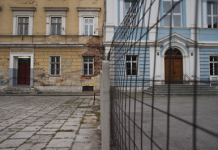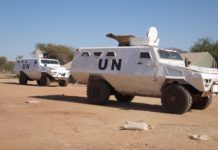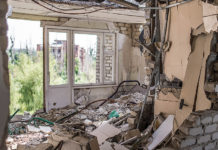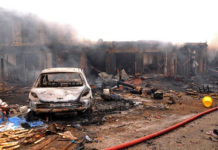The current armed conflict in Syria is now entering its third year. Military operations have left cities and their peri-rural surroundings devastated and divided. Homs, Aleppo, Damascus and many smaller towns such as Qaysa, Halfaya or Khirbet Ghazaleh have been battle field for both rebel and government successive offensives suffered tragic humanitarian consequences : the survival of the inhabitants of these cities looks extremely grim. The battles for these cities have resulted in the breakdown of entire urban systems including the destruction of homes, collapse of public services, and distortion of urban economies. Syria’s previously well-functioning urban health system has collapsed. Markets in the cities are functioning in a haphazard way and food shortages are commonplace. This in turn has led to important population movements within, from and sometimes to the cities, as well as across borders.
War in urban contexts in Syria
Syria is a highly urbanized country with at least half of its 21 million people living in urban and peri-urban areas. Its cities are modern and thus very dependent on electricity, telecommunication networks, and sewage systems all of which are severely disrupted during the conflict. With a population over 1.80 million, Damascus is the center of power in modern Syria. The capital was well-defended by the Syrian military making it difficult for insurgents to infiltrate the suburbs. Once they did, the government responded with intensive aerial bombardment and regular mortar and heavy shelling. The insurgents reacted by penetrating deeper into the city even carrying out hit and run operations against government targets. In other cities, such as Aleppo (which had a pre-war population of almost 3 million people) or Homs (which already suffered much during the reign of the father of the current Syrian leader – Hama massacre in 1982), the impact of the war on the cities has been huge. Adding to the carpet bombing, the recent military operations carried out by Hezbollah special commandos have taken a high toll on the civilian population while making external humanitarian intervention extremely difficult.
The UN Secretary General recently announced that more than 100,000 people have been killed over the last 2.5 years of the Syrian war. The majority of these deaths have occurred in urban areas. According to OCHA, between 5.6 and 5.8 million Syrians (including a large number of Palestinian refugees settled in Syria), have abandoned their homes during the last two years, either in fear of their lives or because living conditions have become unbearable. Of these, 4.25 million are internally displaced persons (IDPs) who to escape violence have been moving within towns, from rural areas to nearby city centers if factional confrontations become too frequent in the countryside or, because these are still relatively safer, from cities to rural areas. Their survival strategies include staying with host families, renting, or occupying empty buildings and public facilities, and organizing communal shelters. An UNHABITAT survey of the Syrian cities it could access, reports that 165,000 people are living in 730 communal shelters in these cities. These are highly mobile populations, moving from one location to another depending on the geographic direction and spread of the fighting. As frequently observed, when active fighting takes place in urban areas, IDP families are forced to move repeatedly, following the rhythm of military operations.
The cities on the other sides
The flow of refugees from Syria to neighboring countries has accelerated from a few tens of thousands in the early months, with most moving to Turkey, to up to 1.6 million spread across all neighboring countries. The establishment of Syrian refugee camps along borders which are now in place since two years creates new “urbanized systems” with their own water and health systems, camp administration, local economy. Access to these camps by aid agencies is now well established with the help of UNHCR, UNWRA and OCHA. The influx of Syrians in cities of the neighboring countries is changing the demographic and religious balance of these areas in the process. This is particularly worrying in Lebanon, where confrontation between Shiites and Sunnis has been re-ignited in cities such as Tripoli in North Lebanon. Access for humanitarian actors in these highly sensitive areas was already difficult before. It is becoming increasingly more difficult. The presence of Hezbollah troops alongside the Damascus army is also likely to have longer term political consequences as it unbalances the relations between Lebanon and Syria.
While precise numbers are not yet available, there are worrying signs that the demographics in cities and peri-urban neighborhoods have changed dramatically during the war. Displacements from more affected cities (Damascus suburbs are sheltering large number of IDP from Allepo) or from rural areas is a frequently reported feature. Large part of the urban Syrian elite and trained manpower left long time ago and this has a significant impact on the functioning of basic services in the cities. The culture clashes resulting from huge numbers of countryside people into urban areas has been frequently reported by IDPs to aid agencies and visiting journalists. The huge increase in demand for increasingly scarce supplies of clean water, food, energy and waste collection and the added pressure on damaged or unmaintained water, sewage, and energy infrastructure adds tension to already highly volatile contexts. Interviews with aid actors working in these urban contexts indicated that this situation, topping up a high level of destruction in infrastructures and extremely limited capacity to bring repair material, makes the re-establishment of basis service extremely difficult.
War in the cities: the different facets of urban warfare in Syria .
To understand the impact of war in Syrian cities, its resulting humanitarian needs and the capacities to respond to them, it is important to understand how urban warfare (Hopkins, 2010; Vautravers, 2010)) is conducted. It is characterized by the use of heavy artillery (airborne or landborne)(1), snipers, and small mobile groups familiar with the terrain (Special Forces on the side of the conventional army, urban guerilla for the opposition). This has major consequences for civilians: the fighting takes place in the middle of densely populated neighborhoods rather than on an open battlefield and heavy shelling is combined with street-to-street or even apartment-to-apartment “search and kill” operations. People have been forced to take refuge in cellars, and are afraid to go out in search of water and food.
Large-scale military operations in urban settings bring another set of challenges: the magnitude of the needs (the wounded often number in the dozens), the fight against time to get people out of the rubble or retrieve the wounded from the streets, and the difficulty of setting up triage and evacuation mechanisms, which in such contexts is often the main cause of death. At this stage, only neighbors and volunteers from either the SARC (limited) or from local institutions can intervene. The classical Urban Search and Rescue deployment is nearly impossible due to the security conditions.
The issue of unexploded ordnance (UXO) and booby trapping is already very critical and will be even more so in the future. Urban warfare in Syrian cities is being conducted through high intensity carpet bombings which result in significant presence of UXO. This, combined with ambushes, sniper attacks and systematic booby trapping, put urban dwellers and humanitarian and rescue teams at huge risk. Going to the bakery became a risky undertaken, as seen by the ugly bombing of poor urban dwellers queuing to buy their bread(2). Urban warfare tactics also make the delivery of aid an extremely risky endeavor. Avoiding becoming a target is the primary objective of Syrian civilians and aid workers alike.
Humanitarian aid in conflict-affected urban areas
Conflict in urban settings in Syria has had several health consequences. Significant numbers of civilians are wounded at any given time and it is very difficult to evacuate them to acceptably equipped health structures. Treating the high number of wounded brought to the health institutions after each of the military operations requires skills, equipments, hygienic conditions, blood. Surgical teams with specialized skills are required as well as sufficient supplies of blood, anesthetic, drugs and disinfectant. Electricity and water must also be available to maintain cold chains and minimum hygiene standards. Capacity to stabilise a wounded patient’s condition and evacuation means are crucially missing when cities become active battle fields. The key element of the strategy here was to ensure that any single opportunity to replenish stocks was used to ensure that a minimal capacity remains in place to cope with difficult times. In addition to poor sanitary and lack aseptic conditions, the limited availability of b is regularly mentioned by surgeons coming back from the field. ICRC, through the SARC, and a few NGOs able to work in some urban areas (MSF, MDM) have tried to ensure that what is needed to enable basic health and surgical care continues to function is provided (equipment, medicine, generators, etc.). The few aid actors present, like MSF and MDM, are working through small-scale health structures which are either very mobile or very discrete and with networks of Syrian practitioners who are frequently assaulted by Government security forces (MDM, 2012). These NGOs have to negotiate the movement of medical teams and supplies from neighboring countries through cross borders operations and across many checkpoints controlled by different groups, making these movements highly hazardous.
As a result of the conflict, humanitarian needs in urban areas are enormous but so far, access and logistical constraints have made it difficult for aid agencies to respond at scale. For relocated families in in schools, classrooms and other public buildings, and for the new coming families who have to stay outside in the playground, with a temperature reaching above 40 degrees in summer water is the number one priority. In Damascus, where the hit can rech more than 40°C in summer, NGOs like Première Urgence –Aide Médicale Internationale and Secours Islamique France have organized water trucking PU-AMI is distributing every day 55,000 liters of water to 5,000 people in 10 schools while SIF is trucking water in other part of Damascus, while rehabilitation small scale sanitation schemes. These types of projects, however useful they are, are just expensive drops in the ocean and cannot be sustained over a long period of time. In winter, winterization programmes, including winter cloths and blankets distribution are essential as life in destroyed houses and in the precarious IDP settlements becomes largely unbearable during the cold Syrian winters. Yet bringing these goods in an impartial way (ie to both sides) into the urban war zones proved very difficult in view of the constraints imposed by the Syrian Government and the still ongoing military operations.
ICRC has tried to negotiate with the Syrian government and insurgent groups permission for the Syrian Arab Red Crescent (SARC) to evacuate civilians – especially the wounded, and women and children – from combat zones in Homs and Aleppo but with limited success as many groups among the insurgents consider the SARC to be a tool of the Government.. Ultimately, the government and most of the opposition groups rejected this move as it would have meant ceding control over territory and people.
While part of the urban governance mechanisms managed to show an incredible resilience in parts of the cities, in others, municipal authorities responsible for running the basic services have in many areas been made idle: their authority jeopardized by the conflict, their infrastructures partly destroyed, part of their staff dispersed in Syria and neigbouring countries, their revenues decreasing rapidly.. Despite that, incredible courage is display to help wonded people and get them into place where they can get basic relief.
The Syrian economy has also been severely affected by the crisis and is expected to continue to decline. Productive sectors have almost come to a standstill due to insecurity in agricultural as well as industrial areas. Disrupted means of transportation, electricity and fuel recurrent shortages worsen the daily life of Syrian people. Urban studies indicate that urban systems require networks to functions, far much that rural ones. In addition, urban way of life is very different that the one in the countryside. The frequent disruption to urban services like water and power not only affects daily life of the cities inhabitants, but also hinders humanitarian response. During the current city wars in Syria, electricity production systems have not been able to function regularly. Maintaining electricity is critical because it provides a sense of normality amidst what is otherwise chaos, although lighting used after dark can also put people at greater risk of attack. Ensuring the access to water is in Syria the responsibility of the Government, while the private sector plays a marginal role mostly in low density residential areas, which are often now hosting IDP (peri-urba Damascus for instance). Different agencies, such as UNICEF and several NGO, are trying to repair water systems, bring water purification chemical to resupply the some of the still operating water treatment plant, trucking water and dispensing water purification tablets to provide clean drinking water to Syrian families in the cities. For displaced families staying in schools and public buildings, and especially for those forced to stay outside in summer temperatures, water is the number one priority; in Damascus, where in summer temperatures can exceed 40°C !
For people in conflict-affected Syrian cities, as in many other war-affected urban contexts, rapid and reliable access to information has been a lifeline. Telecommunications, radios, internet connections, and access to TV networks have allowed the besieged urban population to maintain links with family and the outside world. Cellular telephone networks, in particular, have enabled urbanites to communicate with relatives who are in other parts of Syria or in refugee camps, and also with the Diaspora. But they have also been used to direct combat operations and monitor other belligerents. The existence of these ITC systems is crucial to establish contacts, to monitor needs and whatever aid interventions are taking place. In the future, these systems will play a critical role in enabling cash transfers, reestablishing family links, and in the remote monitoring of humanitarian assistance, but also of security. Their repair will be essential for the coming humanitarian aid and recovery phases.
While the municipal authorities normally have responsibility for running the cities, their authority has been largely undermined by the conflict. Fighting between factions has divided cities into areas controlled by the Central state and those controlled by a constellation of different armed groups. These Katibas (tribal or clan militia) have limited notions of what “territorial governance” and service delivery is. Aid agencies had to build relationships with them it them in order to work in the areas they controlled. But rapidly relevant municipal authorities will have to be restored in their coordination role.
To effectively support conflict-affected people in Syrian cities means working in very complex, volatile, unpredictable and dangerous environments. Several key issues are at stake:
– To work in the extremely challenging context of war torn Syrian cities, agencies have to be agile, flexible, opportunistic, and risk taking. Classical operational modalities imposed by donors’ procedures or “good practice guidelines”, which require lengthy planning, standardized modus operendi and sophisticated accountability mechanisms do not work in these highly volatile and complex urban contexts, as shown is the growing body of documents now available(3).
– Insecurity and danger are the defining characteristics of operating in Syria in general and in Syrian cities in particular. The reliance on national staff or national NGO and the overreliance on remote control represent a risk transfer and raise many ethical dimensions, as well as accountability issues. Agencies working through these modalities either from Amman or the Turkish border are regularly reporting on the difficulties of controlling and monitoring aid without proper presence. The small number of NGO operating through cross border operations with expatriate staff are taking high risks in order to continue to work side by side with their Syrian colleagues ,
– Effective humanitarian response in conflict-affected urban areas in Syria requires a capacity to engage in strategic dialogue, firmly rooted in humanitarian principles, with a wide range of different actors including the government, the political/religious factions and associated armed militias and with what remains of municipal institutions. When the urban contexts are tightly controlled by anti-western fundamentalist groups, it is very delicate to operate and negotiate access. The quality of the local networks and the capacity to bring these group to recognized the usefulness of the presence of western aid actors is critical to negotiate safe and regular access to all people in need. Most aid agencies are ill equipped to do this as they often lack language and negotiation skills, a good understanding of both the urban and underlying socio-political context, the networks to facilitate the necessary connections, and crucially, the courage to take risks.
– The conduct of the hostilities often leaves behind largely contaminated areas (both unexploded ordinances and deliberate booby traps) requiring high level of awareness as any significant battle area clearance (BAC) cannot take place before the return of more peaceful times.
– The destruction of the social fabric that historically contributed to the creation of “the city” often results in a high level of lawlessness. The resulting insecurity affects the capacity of the inhabitants to keep the few items they manage to save or to collect for their survival, although some actors interviewed indicated that the imposition of the Charia in the areas where they work plays a “de-incentive role” against normal banditry. It also put aid agency personnel at risk as hostage-taking is becoming a flourishing sector in Syria.
Hopefully, one day, peace will come back: Reconstructing the urban infrastructure (buildings, roads, water and sewage systems etc) damaged or destroyed during the conflict will be a costly and long-term endeavor. Even the most urgent reconstruction interventions will have to be preceded by decontamination teams to ensure safe access to these areas. The creation of the conditions for reconstruction will imply the rapid deployment of decontamination squads to clear mines, UXO and booby traps so that people can return home. But the reconstruction of what makes a city a dynamic and vivid entity (social fabric, social institutions, neighborhood solidarity, cultural life and urban economy) will take even longer….
(1) http://www.telegraph.co.uk/news/worldnews/middleeast/syria/9462500/Amnesty-International-release-aerial-photos-of-Syrian-city-of-Aleppo.html
(2) http://www.hrw.org/news/2012/08/30/syria-government-attacking-bread-lines
(3) Humanitarian aid in urban contexts, UNHABITAT- 2011, Humanitarian aid in urban setting, Groupe URD, 2012, « Learning from the City », British Red Cross 2013,
Consulted bibliography
ALNAP. 2011. 27th ALNAP meeting Chennai India background-paper. http://www.alnap.org/pool/files/27-background-paper.pdf
BOYER Beatrice, 2010, Villes afghans, défis urbains: les enjeux de la reconstruction post conflit ; ed Karthala/Groupe URD, Paris, 407 p.
BRAUN Georg, 1617, Civitates orbis terrarium, Koln, republished as “Cities of the renaisssance world”, 2008, Compendium publishing, London, 264 p.
DUIJSEN Raymond, 2010, Humanitarian challenges of urbanization in “International review of the red cross, Volume 92 Number 878 June 2010, pp.351-368, http://www.icrc.org/eng/resources/international-review/review-878-urban-violence/index.jsp
EGLAN Jan, HARMER Adele & STODDARD Abby, 2001, To stay and deliver: good practice for humanitarians in complex security environments; OCHA, New York; 87 p.
GROUPE URD. 2011. Humanitaires en Mouvement n°8/la ville face aux crises. http://www.urd.org/IMG/pdf/URD_HEM_8_papier_FR_V2_HD.pdf.
GRUNEWALD François ; 2005, Fragiles cités, In Diplomatie, numéro 17, Novembre-Décembre 2005, pp. 69-79.
GRUNEWALD F et LEVRON E, 2004, Villes en guerre et Guerres en ville ; Ed Karthala, Paris, 392 p .
GRUNEWALD F & DE GEOFFROY V ; 2008, Evaluation of DG ECHO-UNRWA partnership
HAROFF TAVEL Marion, 2010, Violence and humanitarian action in urban areas. New challenges, new approaches, in “International review of the red cross, Volume 92 Number 878 June 2010, pp.329-350, http://www.icrc.org/eng/resources/international-review/review-878-urban-violence/index.jsp
HOPKINS Micheal John ; 2010, Regulating the conduct of urban warfare: lessons from contemporary asymmetric armed conflicts; in Urban Violence, International review of the Red Cross, Vol 92; N°878, June 2010; pp 469-493
MDM, 2012 ; Soigner en Syrie et aux frontières,témoigner des souffrances, Paris ; 6 p.
MSF : 2010, Humanitarian negotiations….
UN HABITAT. 2010. Meeting Humanitarian Challenges in Urban Areas, Review of urban humanitarian challenges in port -au- prince, Manila, Nairobi, Eldoret.
VAUTRAVERS Alexandre, 2010 ; Military operations in urban areas ; in Urban Violence, International review of the Red Cross, Vol 92; N°878, June 2010; pp 437-452
François Grünewald
Derniers articles parFrançois Grünewald (voir tous)
- Charlie : Pour en finir avec quelques dichotomies mortelles – 2 février 2015
- Risques sanitaires passés, présents et à venir : sur la piste d’Ebola – 6 janvier 2015
- Gaza, chronique d’un désastre annoncé – 1 septembre 2014










